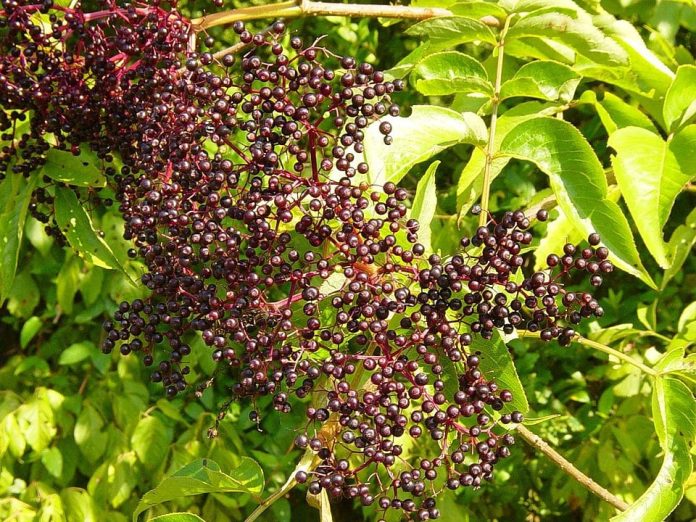
Photo by Franklin Bonner / CC BY-SA 3.0
A field guide on how to identify & propagate Canadian Elderberry (Sambucus nigra canadensis), a hardy shrub that is native to eastern North America.
How to Identify Canadian Elderberry (Sambucus nigra canadensis)
Leaves
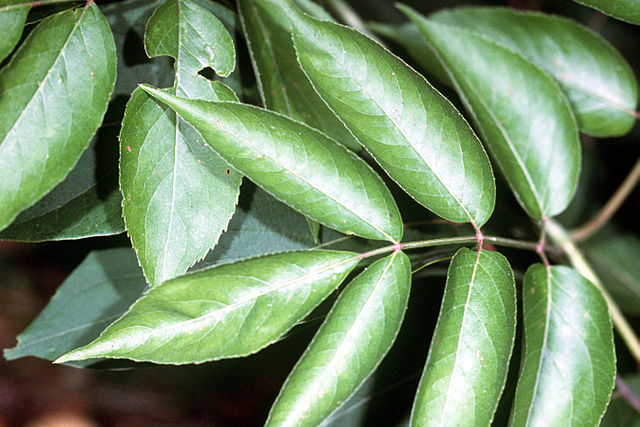
Canadian elderberry leaves are elliptical to lance-shaped, have serrulate margins, and grow on the stems in opposite arrangements.
Fruit
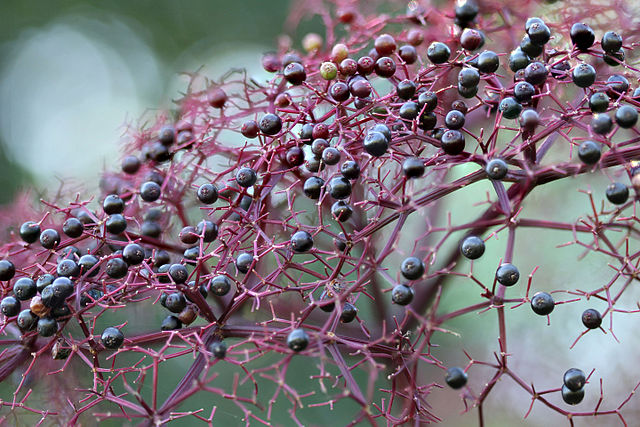
Canadian elderberry produces small, dark purple to black berries that grow in clusters. These berries are often used for culinary purposes, such as in jams, jellies, and pies, and are known for their sweet and slightly tart flavor.
Flower
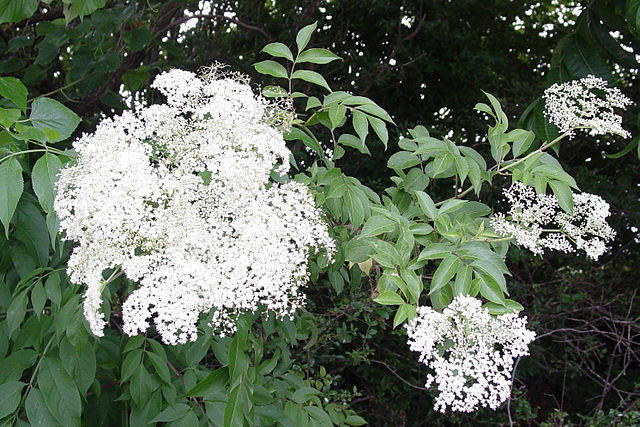
The flowers of Sambucus nigra canadensis are creamy white and grow in clusters, typically in the early summer months. They have a sweet, floral fragrance and are commonly used to make elderflower syrup, tea, or other beverages.
Flowering Season
Canadian elderberry typically blooms from late spring into early and mid-summer.
Fruits appear later in the summer and ripen by late summer to early fall.
Habitat
Elderberry likes to grow in moist, well-drained and sunny places, such as near streams or on slopes. It can grow in different types of habitats and at different elevations, from 3 to 3000 meters.
Look for Canadian elderberry near bodies of water like streams, rivers and lake sides.
Some other understory plants that associate with Canadian elderberry are:
- Serviceberry (Amelanchier alnifolia)
- Common Snowberry (Symphoricarpos albus)
- Chokecherry (Prunus virginiana)
Wildlife Value
Canadian elderberry (Sambucus nigra canadensis) has significant wildlife value as its flowers and berries provide important food sources for a variety of animals, particularly birds.
For example, the berries are consumed by several bird species such as the cedar waxwing (Bombycilla cedrorum), American robin (Turdus migratorius), and purple finch (Haemorhous purpureus).
The flowers of elderberry attract pollinators, including butterflies and bees, which are also important to the ecosystem.
Additionally, elderberry can provide habitat for birds to nest and seek shelter, and its foliage and branches may be used by small mammals for cover.
How to Propagate Canadian Elderberry (Sambucus nigra canadensis)

Hardiness Zone: 3-9

Soil Type: Most, well-drained chalk, clay, loam, and sand.

Water: Normal.

Exposure: Full Sun to Partial Shade
You can propagate Canadian elderberry with two effective methods:
- Stem Cuttings: It provides established trees faster, but is tricky, and will probably have a lower success rate.
- By Seed: The success rate is high but takes longer to get established saplings.
How to Propagate Canadian Elderberry (Sambucus nigra canadensis) by Seed
If you have access to wild elderberry bushes near you, you can harvest the seeds yourself.
If not, you can always order the seeds online at sheffields.
How to Harvest Seeds
There are two ways to harvest the seeds from the fruits.
- The first option involves cutting open the fruits and extracting the seeds with tweezers, which is very time consuming.
- The second option is to use a blender to blend the fruits, strain the mixture, remove the pulp, strain it again, and collect the small seeds.
After harvesting, it’s essential to let the seeds dry thoroughly to store them properly. For air drying, keep them in a cool, well-ventilated area away from direct sunlight.
Try to avoid storing the seeds for too long as they’ll lose their viability.
Did you know? You can store the fresh fruits in the freezer and do part of the cold stratification like that.
Sowing
For outdoor sowing, plant in the fall for sprouting in the following spring.
For indoor sowing, elderberry seeds require cold stratification which can be done as follows:
- Place seeds in a ziplock bag with damp sand and label with the name and date.
- Store in the refrigerator for 60 days, then soak in room temperature water for 12 hours.
- Return to the ziplock bag and refrigerate for an additional 30 days.
- Once the stratification process is complete, plant the seeds under 1/4 inch of potting soil, keep moist, and cover with plastic wrap to maintain humidity.
How to Propagate Canadian Elderberry (Sambucus nigra canadensis) by Cuttings
A great method to propagate elderberry is by taking hardwood cuttings. The best time to do that is late fall or early spring when the shrub is still dormant.
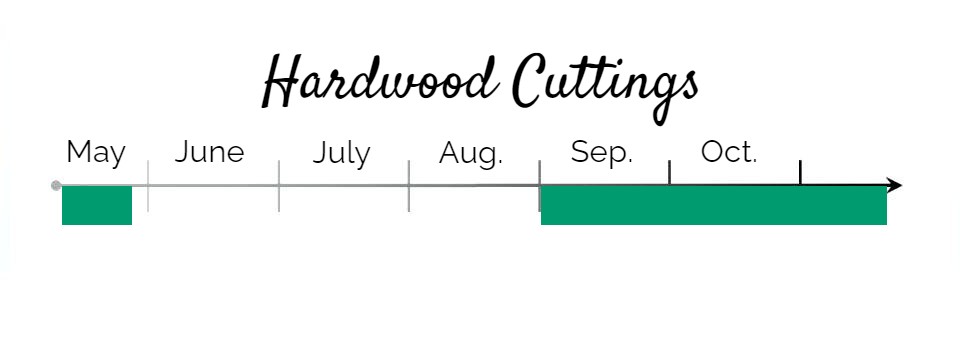
Very important: Choose a young, healthy plant to take cuttings from. Older shrubs are less vigorous and harder to root!
Step 1: Harvest the Cuttings
- Look for branches with new growth from the previous year or two.
- Cut below a node, ensuring the width is at least 1/4″ to 1/2″ each, and trim any forking branches.
- Cut the branch into 6-8 inch long cuttings with multiple pairs of nodes.
Step 2: Root the Cuttings
- Use a well-drained, well-aerated mix like peat moss with perlite.
- Place cuttings in indirect sunlight, ensuring the leaf nodes are facing the right direction.
- Keep the medium moist and well-ventilated to prevent rot.
- Elderberry cuttings root in about 3-4 weeks.
- Wait at least 8 weeks for the roots to establish before transplanting.
FAQ
A: Yes, Canadian elderberry (Sambucus canadensis) is edible, with its berries commonly used to make jams, syrups, and other culinary treats. However, it’s important to properly identify the plant and avoid consuming any toxic look-alike species.
A: Canadian elderberry is found mostly in the eastern regions of North America.
A: European elderberry grows more like a tree, up to 20 feet, as opposed to American elderberry, which grows more like a shrub, up to 10 feet.
A: Yes, pokeweed and devil’s walking stick are elderberry lookalikes.
